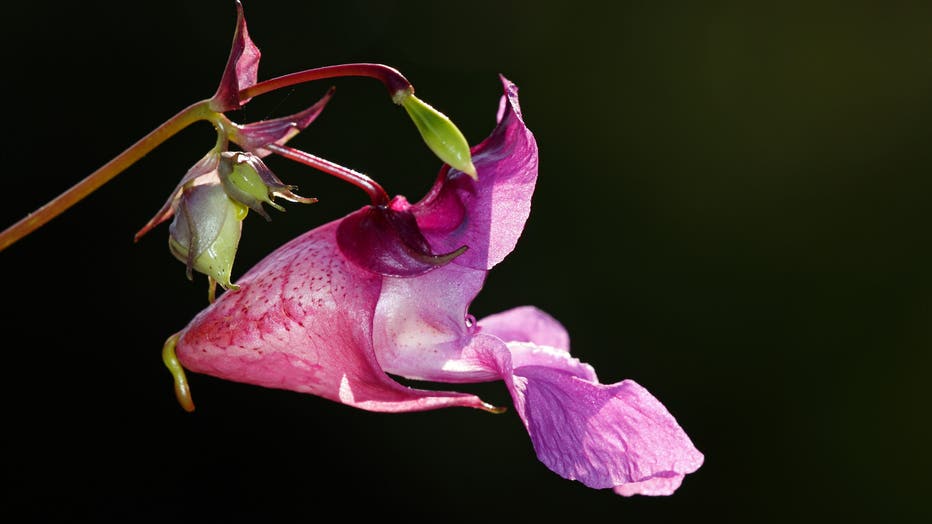Purple jewelweed, an invasive species in Michigan's U.P. that officials hope to eradicate

CHOMRONG, KASKI DISTRICT, NEPAL - 2016/09/28: A blooming blossom of Policemans helmet (Impatiens glandulifera). (Photo by Frank Bienewald/LightRocket via Getty Images)
(FOX 2) - While running the invasive species station during an elementary school event in Michigan's Upper Peninsula, Elise Desjarlais was presenting to students when one raised his hand.
"I have that plant," he said, pointing to the picture of the purple flower on the sign that Desjarlais was presenting in front of. "My sister and I play with the seed pods. We like to watch them explode."
It didn't take long to track down the student's parent, who then showed Desjarlais where the suspected invader was growing. Sure enough, there was purple jewelweed - the second population to be found in a small village in Alger County.
"The outreach is working. Unfortunately, we're finding more things - but maybe that's also fortunate," said Desjarlais, who is coordinator for the Lake to Lake invasive species monitoring group.
The charming pink flower with a seed pod that detonates when touched is the focus of multiple U.P. monitoring agencies on the lookout for the invader.
Traditionally known as Himalayan Balsam, managers are referring to the species as purple jewelweed in an effort to better identify and communicate the plant to the public.
But while purple jewelweed is considered a high priority species, the success that monitors like Desjarlais have had in removing infestations has them setting their sights on a lofty goal: total eradication.
"We jokingly put it as ‘don’t say the e word' since the goal isn't realistic for many (invasive) species," she told FOX 2. "That's why this one is different."
Purple Jewelweed is native to Asia but emerged in the U.P. in 2010, first showing up in Sault Ste. Marie after likely spreading from Canada's Ontario province, which is managing a much larger outbreak.

(GERMANY OUT) flowering Himalayan Balsam, Indian Balsam (Impatiens glandulifera) (Photo by Cuveland/ullstein bild via Getty Images)
Each plant features up to 10 flowers per stem, which bloom in July and August, and carries a sweet scent. The flowers are shaped like a policeman's helmet. And similar to their native orange-colored cousins, sprout seed pods that will burst when disturbed.
Like many invasive species, purple jewelweed has traits that make it easy to flourish in regions it doesn't belong to. It produces a large amount of nectar, attracting pollinators and facilitating their spread.
It out-competes native species, worsens erosion after settling along riverbanks, and forms dense monocultures once it starts growing.
Fortunately, removing it from a site is fairly easy and only requires a couple of years of continued removal before the local infestation is totally removed. That's because the seed is only viable for two years before dying.
Of the 11 actively managed sites in the eastern U.P., officials hope to have five of them eradicated within the next three years. Lillian Lacross, who works with the Three Shores monitoring group, said last year her team helped remove 800 pounds of the plant.
Native grasses were planted in their place, she said, which is now part of the invasive species management kits her team offers after neighbors remove the invader.
"(They can) trade those bags of pulled purple jewelweed in for native plant plugs, so homeowners could not only pull their own purple jewelweed, but also plant their own native plants and restore their own land," she said during a recent webinar about the invasive plant.
When public outreach is robust and communities buy into the effort of removing non-native plants, that's what Desjarlais calls "the ideal situation in invasive species management."


